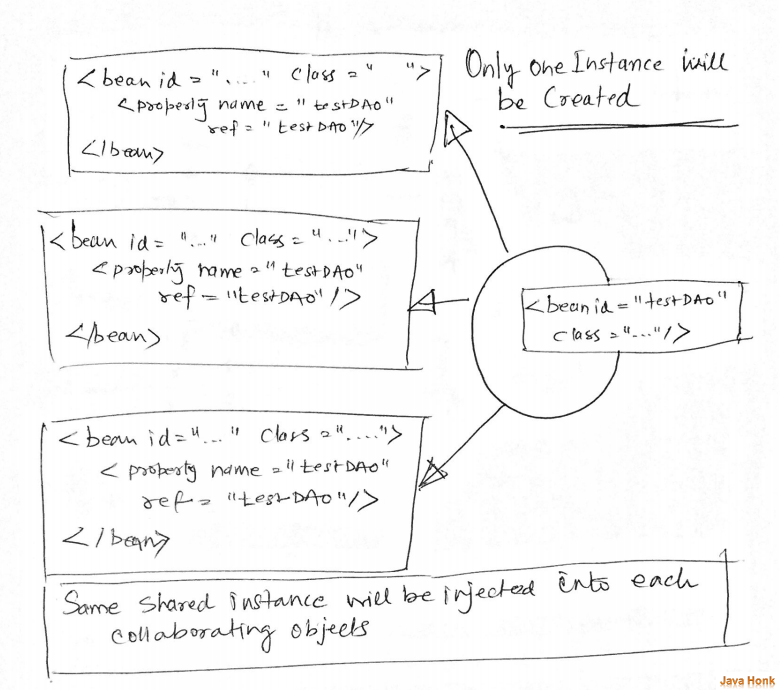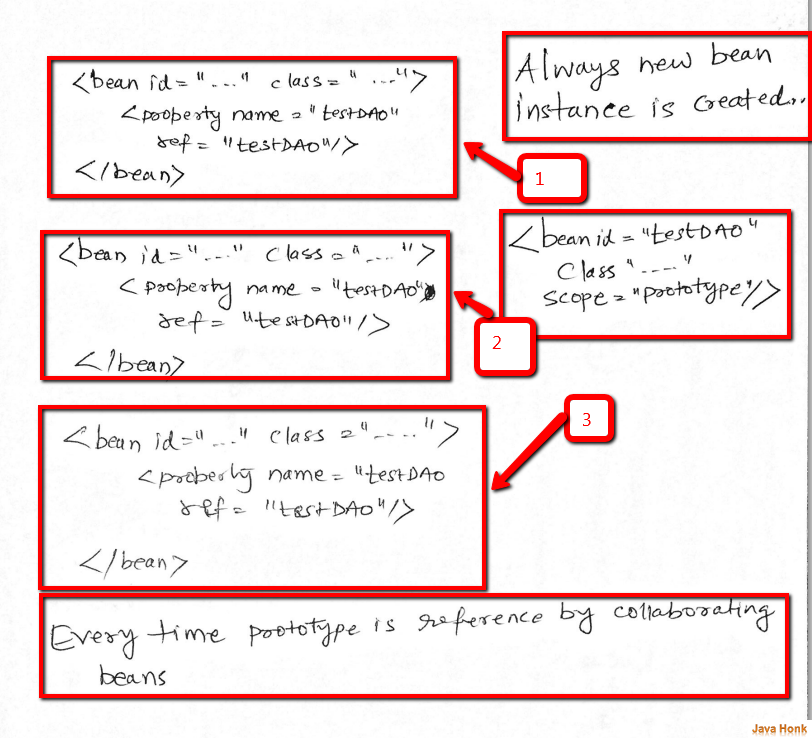Spring Bean Scopes :
Bean instantiation in spring framework support five types of scopes:
1. Singleton scope : When you define a bean definition and it’s scoped as a singleton, then the Spring IOC container will create exactly one instance of the object defined by that bean definition. This single instance will be stored in a cache of such singleton beans, and all subsequent requests and references for that named bean will result in the cached object being returned.
Note: Default bean scope is always Singleton
2. Prototype scope : The non-singleton, prototype scope of bean deployment results in the creation of a new bean instance every time a request for that specific bean is made (that is, it is injected into another bean or it is requested via a programmatic getBean() method call on the container). As a rule of thumb, you should use the prototype scope for all beans that are stateful, while the singleton scope should be used for stateless beans.
Note: DAO would not typically be configured as a prototype, since a typical DAO would not hold any conversational state as shown in picture above.
3. Request scope : See below definition:
<bean id="loginAction" class="com.foo.LoginAction" scope="request"/>
With the above bean definition in place, the Spring container will create a brand new instance of the LoginAction bean using the ‘loginAction’ bean definition for each and every HTTP request. That is, the ‘loginAction’ bean will be effectively scoped at the HTTP request level. You can change or dirty the internal state of the instance that is created as much as you want, safe in the knowledge that other requests that are also using instances created off the back of the same ‘loginAction’ bean definition will not be seeing these changes in state since they are particular to an individual request. When the request is finished processing, the bean that is scoped to the request will be discarded.
4. Session scope : See below definition:
<bean id="userPreferences" class="com.foo.UserPreferences" scope="session"/>
With the above bean definition in place, the Spring container will create a brand new instance of the UserPreferences bean using the ‘userPreferences’ bean definition for the lifetime of a single HTTP Session. In other words, the ‘userPreferences’ bean will be effectively scoped at the HTTP Session level. Just like request-scoped beans, you can change the internal state of the instance that is created as much as you want, safe in the knowledge that other HTTP Session instances that are also using instances created off the back of the same ‘userPreferences’ bean definition will not be seeing these changes in state since they are particular to an individual HTTP Session. When the HTTP Session is eventually discarded, the bean that is scoped to that particular HTTP Session will also be discarded.
5. Global session scope : See below definition:
<bean id="userPreferences" class="com.foo.UserPreferences" scope="globalSession"/>
The global session scope is similar to the standard HTTP Session scope (described immediately above), and really only makes sense in the context of portlet-based web applications. The portlet specification defines the notion of a global Session that is shared amongst all of the various portlets that make up a single portlet web application. Beans defined at the global session scope are scoped (or bound) to the lifetime of the global portlet Session.
Please note that if you are writing a standard Servlet-based web application and you define one or more beans as having global session scope, the standard HTTP Session scope will be used, and no error will be raised.

